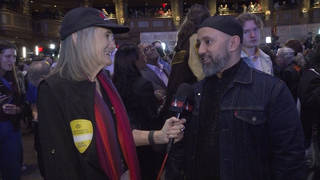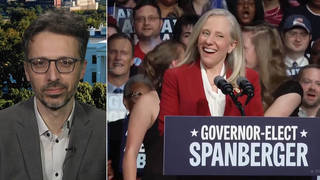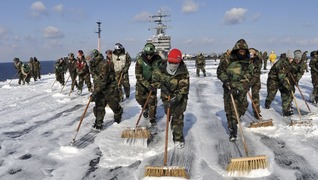
Guests
- Dr. Michio Kakua Japanese American physicist and bestselling author. He is a professor of theoretical physics at the City College of New York. His new book is Physics of the Future: How Science Will Change Daily Life by 2100.
The Japanese government is trying to calm fears about radiation levels and food safety in the region around the heavily damaged Fukushima Daiichi nuclear power facility, even as it has raised the severity rating of the crisis to the highest possible level. “Radiation is continuing to leak out of the reactors. The situation is not stable at all,” says Dr. Michio Kaku, professor of theoretical physics at the City University of New York and the City College of New York. “The slightest disturbance could set off a full-scale meltdown at three nuclear power stations, far beyond what we saw at Chernobyl.” [includes rush transcript]
Transcript
AMY GOODMAN: Japanese Prime Minister Naoto Kan tried Tuesday to calm fears about radiation levels and food safety in the region around the heavily damaged Fukushima nuclear power plant. His comments came after Japan raised the severity rating of its nuclear crisis to the highest possible level, heightening concerns about the magnitude of the disaster.
Speaking at a news conference to mark one month since the massive earthquake and tsunami devastated the northeastern coast of the country, Japanese Prime Minister Kan said produce from the region around the Fukushima plant is safe to eat despite radiation leaks.
PRIME MINISTER NAOTO KAN: [translated] From now on, people should not fall into an extreme self-restraint mood, and they should live life as normal. To consume products from the areas that have been affected is also a way in which to support the area. We should enjoy the use of such products and support the areas that have been affected. I ask you to do this.
AMY GOODMAN: A spokesperson for the International Atomic Energy Agency said the latest food sample data indicates levels of contamination are below the limits set by domestic authorities. Denis Flory, IAEA spokesperson, also said yesterday Japan’s nuclear crisis was not comparable to Chernobyl.
DENIS FLORY: The mechanics of the accidents are totally different. One happened when a reactor was at power, and the reactor containment exploded. In Fukushima, the reactor was stopped, and the containment, even if it may be somehow leaking today — and we do not know — the containment is here. So this is a totally different accident.
AMY GOODMAN: Japanese officials said they raised the severity level to 7 because of the total release of radiation at the Fukushima Daiichi power plant, not because of a sudden deterioration in the situation. The 1986 Chernobyl disaster is the only other nuclear accident rated at the highest level, 7, on a scale developed by the International Atomic Energy Agency to assess nuclear accidents. But officials insist so far the power plant in Japan has released one-tenth as much radioactive material as Chernobyl.
To discuss the situation in Japan, as well as his latest book, we’re joined by Dr. Michio Kaku, a Japanese American physicist, a bestselling author, professor of theoretical physics at City University of New York and the City College of New York. His brand new book is Physics of the Future: How Science Will Change Daily Life by 2100.
Welcome to Democracy Now! It’s great to see you again.
DR. MICHIO KAKU: Glad to be on the show, Amy.
AMY GOODMAN: So, talk about this raising of the category level to 7, on a par with Chernobyl.
DR. MICHIO KAKU: Well, Tokyo Electric has been in denial, trying to downplay the full impact of this nuclear accident. However, there’s a formula, a mathematical formula, by which you can determine what level this accident is. This accident has already released something on the order of 50,000 trillion becquerels of radiation. You do the math. That puts it right smack in the middle of a level 7 nuclear accident. Still, less than Chernobyl. However, radiation is continuing to leak out of the reactors. The situation is not stable at all. So, you’re looking at basically a ticking time bomb. It appears stable, but the slightest disturbance — a secondary earthquake, a pipe break, evacuation of the crew at Fukushima — could set off a full-scale meltdown at three nuclear power stations, far beyond what we saw at Chernobyl.
AMY GOODMAN: Talk about exactly — I mean, as a physicist, to explain to people — exactly what has taken place in Japan at these nuclear power plants.
DR. MICHIO KAKU: Think of driving a car, and the car all of a sudden lunges out of control. You hit the brakes. The brakes don’t work. That’s because the earthquake wiped out the safety systems in the first minute of the earthquake and tsunami. Then your radiator starts to heat up and explodes. That’s the hydrogen gas explosion. And then, to make it worse, the gas tank is heating up, and all of a sudden your whole car is going to be in flames. That’s the full-scale meltdown.
So what do you do? You drive the car into a river. That’s what the utility did by putting seawater, seawater from the Pacific Ocean, in a desperate attempt to keep water on top of the core. But then, seawater has salt in it, and that gums up your radiator. And so, what do you do? You call out the local firemen. And so, now you have these Japanese samurai warriors. They know that this is potentially a suicide mission. They’re coming in with hose water — hose water — trying to keep water over the melted nuclear reactor cores. So that’s the situation now. So, when the utility says that things are stable, it’s only stable in the sense that you’re dangling from a cliff hanging by your fingernails. And as the time goes by, each fingernail starts to crack. That’s the situation now.
AMY GOODMAN: What about the food, the level of contamination of the food? They are increasingly banning food exports.
DR. MICHIO KAKU: The tragedy is, this accident has released enormous quantities of iodine, radioactive iodine-131, into the atmosphere, like what happened at Chernobyl, about 10 percent the level of Chernobyl. Iodine is water soluble. When it rains, it gets into the soil. Cows then eat the vegetation, create milk, and then it winds up in the milk. Farmers are now dumping milk right on their farms, because it’s too radioactive. Foods have to be impounded in the area.
And let’s be blunt about this: would you buy food that says “Made in Chernobyl”? And the Japanese people are also saying, “Should I buy food that says 'Made in Fukushima'?” We’re talking about the collapse of the local economy. Just because the government tries to lowball all the numbers, downplay the severity of the accident, and that’s making it much worse.
AMY GOODMAN: What do you think has to be done now? I mean, one of the biggest problems is secrecy, both with the Tokyo company that runs the plants and also the government, the constant downplaying from the beginning. And yet, there are so many people who have been evacuated, who are demanding compensation. There was just a major protest at TEPCO with the people in the area who have been evaluated — no jobs, no money — saying, “We demand compensation.”
DR. MICHIO KAKU: Well, TEPCO is like the little Dutch boy. All of a sudden we have cracks in the dike. You put a finger here, you put a finger there. And all of a sudden, new leaks start to occur, and they’re overwhelmed.
I suggest that they be removed from leadership entirely and be put as consultants. An international team of top physicists and engineers should take over, with the authority to use the Japanese military. I think the Japanese military is the only organization capable of bringing this raging accident under control. And that’s what Gorbachev did in 1986. He saw this flaming nuclear power station in Chernobyl. He called out the Red Air Force. He called out helicopters, tanks, armored personnel carriers, and buried the Chernobyl reactor in 5,000 tons of cement, sand and boric acid. That’s, of course, a last ditch effort. But I think the Japanese military should be called out.
AMY GOODMAN: To do…?
DR. MICHIO KAKU: Because of the fact that the radiation levels are so great, workers can only go in for perhaps 10 minutes, 15 minutes at a time, and they get their year’s dose of radiation. You’re there for one hour, and you have radiation sickness. You vomit. Your white corpuscle count goes down. Your hair falls out. You’re there for a day, and you get a lethal amount of radiation. At Chernobyl, there were 600,000 people mobilized, each one going in for just a few minutes, dumping sand, concrete, boric acid onto the reactor site. Each one got a medal. That’s what it took to bring one raging nuclear accident under control. And I think the utility here is simply outclassed and overwhelmed.
AMY GOODMAN: And yet, these workers are in for much longer periods of time.
DR. MICHIO KAKU: That’s right. And we don’t even know how much radiation levels they’re getting, because many areas around the site have no monitors. So we don’t even know how much radiation many of these workers are getting. And that’s why I’m saying, if you have access to the military, you can have the option of sandbagging the reactor, encasing it in concrete, or at least have a reserve of troops that can go in for brief periods of times and bring this monster under control.
AMY GOODMAN: What about the evacuation zone? Is it big enough?
DR. MICHIO KAKU: It’s pathetic. The United States government has already stated 50 miles for evacuating U.S. personnel. The French government has stated that all French people should consider leaving the entire islands. And here we are with a government talking about six miles, 10 miles, 12 miles. And the people there are wondering, “What’s going on with the government? I mean, why aren’t they telling us the truth?” Radiation levels are now rising 25 miles from the site, far beyond the evacuation zone. And remember that we could see an increase in leukemia. We could see an increase in thyroid cancers. That’s the inevitable consequence of releasing enormous quantities of iodine into the environment.
AMY GOODMAN: What has to happen to the plant ultimately?
DR. MICHIO KAKU: Well, in the best-case scenario — this is the scenario devised by the utility itself — they hope to bring it under control by the end of this year. By the end of this year, they hope to have the pumps working, and the reaction is finally stabilized by the end of this year.
AMY GOODMAN: Oddly, it’s sounding a little bit like BP when they were trying to plug up the hole.
DR. MICHIO KAKU: Right.
AMY GOODMAN: “It will happen. It will happen.”
DR. MICHIO KAKU: They’re literally making it up as they go along. We’re in totally uncharted territories. You get any nuclear engineering book, look at the last chapter, and this scenario is not contained in the last chapter of any nuclear engineering textbook on the planet earth. So they’re making it up as they go along. And we are the guinea pigs for this science experiment that’s taking place. Then it could take up to 10 years, up to 10 years to finally dismantle the reactor. The last stage is entombment. This is now the official recommendation of Toshiba, that they entomb the reactor over a period of many years, similar to what happened in Chernobyl.
AMY GOODMAN: Entomb it in…?
DR. MICHIO KAKU: In a gigantic slab of concrete. You’re going to have to drill underneath to make sure that the core does not melt right into the ground table. And you’re going to put 5,000 tons of concrete and sand on top of the flaming reactor.
AMY GOODMAN: Should people be concerned about any food that says “From Japan”?
DR. MICHIO KAKU: Not from Japan. But remember, in the area, the sea, we’re talking about levels that are millions of times beyond legal levels found right there. However, as you start to get out further, radiation levels drop rather considerably.
AMY GOODMAN: I wanted to talk about policy in this country. I mean, we are now seeing happening in Japan this horrific event. Japan was the target of the dawn of the Nuclear Age, right?
DR. MICHIO KAKU: Mm-hmm.
AMY GOODMAN: The U.S. dropping of the atomic bombs on Hiroshima, Nagasaki. Your own family mirrors the history of the Nuclear Age. Can you talk just briefly about that, before we talk about current U.S. policy?
DR. MICHIO KAKU: Yeah, first of all, I have relatives in Tokyo, and they’re wondering about evacuation. In fact, some of my relatives have already evacuated from Tokyo. They have little children. And radiation has already appeared in the drinking water in Tokyo. And so, people are wondering, you know, especially for young children, for pregnant women, should they leave. People are voting with their feet now. A lot of people are voluntarily evacuating from Tokyo, because they simply don’t believe the statements of the utility, which have consistently lowballed all the estimates of radiation damage.
AMY GOODMAN: And, though, in the past, in terms of your own family’s history, your parents, being interned in the Japanese American internment camps?
DR. MICHIO KAKU: That’s right. In California, my parents were interned in the relocation camps from 1942 to 1946, four years where they were put essentially behind barbed wire and machine guns, under the supervision of the United States military.
AMY GOODMAN: And yet, you became a nuclear physicist, interestingly enough, and you worked with the people who made the atomic bombs that were dropped on Japan.
DR. MICHIO KAKU: Yeah. In fact, my high school adviser was Edward Teller, the father of the hydrogen bomb. And he arranged for me to get a scholarship to Harvard, in fact, and that began my career as a nuclear scientist. And Edward Teller, of course, wanted me to work on the Star Wars program. He put a lot of pressure and said, “Look, we’ll give you fellowships, scholarships. Go to Los Alamos National Laboratory, Livermore National Laboratory. Design hydrogen bombs.” But I said no. I said, “I cannot see my expertise being used to advance the cause of war.”
AMY GOODMAN: And you’ve been very outspoken when it comes to nuclear power in the United States. This, of course, has raised major issues about nuclear power plants around the world, many countries saying they’re not moving forward. President Obama is taking the opposite position. He really is very much the nuclear renaissance man. He is talking about a nuclear renaissance and has not backed off, in fact reiterated, saying this will not stop us from building the first nuclear power plants in, what, decades.
DR. MICHIO KAKU: Well, there’s something called a Faustian bargain. Faust was this mythical figure who sold his soul to the devil for unlimited power. Now, the Japanese government has thrown the dice with a Faustian bargain. Japan has very little fossil fuel reserves, no hydroelectric power to speak of, and so they went nuclear. However, in the United States, we’re now poised, at this key juncture in history, where the government has to decide whether to go to the next generation of reactors. These are the so-called gas-cooled pebble bed reactors, which are safer than the current design, but they still melt down. The proponents of this new renaissance say that you can go out to dinner and basically have a leisurely conversation even as your reactor melts down. But it still melts. That’s the bottom line.
AMY GOODMAN: And so, what do you think should happen? Do you think nuclear power plants should be built in this country?
DR. MICHIO KAKU: I think there should be a national debate, a national debate about a potential moratorium. The American people have not been given the full truth, because, for example, right north of New York City, roughly 30 miles north of where we are right now, we have the Indian Point nuclear power plant, and the Nuclear Regulatory Commission has now admitted that of all the reactors prone to earthquakes, the one right next to New York City is number one on that list. And the government itself, back in 1980, estimated that property damage would be on the order of about $200 billion in case of an accident, in 1980 dollars, at the Indian Point nuclear power station.
AMY GOODMAN: No private corporation could even build a nuclear power plant: you have to have the taxpayers footing the bill.
DR. MICHIO KAKU: You have to have what is called the Price-Anderson Act, having the United States government guarantee the insurance. Nobody will guarantee — nobody will sell an insurance policy for a nuclear power plant, because who can afford a $200 billion accident? That’s why the United States government has underwritten the insurance for every nuclear power plant. So the Price-Anderson Act is an act of Congress that mandates the U.S. government, the taxpayers, will underwrite the insurance, because nuclear power stations are not insurable.
AMY GOODMAN: We’re talking to Dr. Michio Kaku. We’re going to go to break, and when we come back, we want to ask him about, well, his new book, Physics of the Future: How Science Will Change Daily Life by 2100. What would be a day in the life of the future? Is it possible that, oh, the internet can be in your contact lens, that cars will drive themselves? Just what we’ll ask Dr. Kaku when we come back. Stay with us.












Media Options